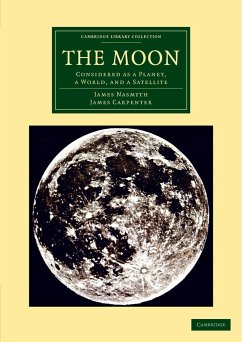- Broschiertes Buch
- Merkliste
- Auf die Merkliste
- Bewerten Bewerten
- Teilen
- Produkt teilen
- Produkterinnerung
- Produkterinnerung
First published in 1874, this monograph is notably illustrated with photographs of accurate plaster models of the lunar surface.
Andere Kunden interessierten sich auch für
![On the Motion of the Heart and Blood in Animals On the Motion of the Heart and Blood in Animals]() William HarveyOn the Motion of the Heart and Blood in Animals30,99 €
William HarveyOn the Motion of the Heart and Blood in Animals30,99 €![Theory of Heat Theory of Heat]() James Clerk MaxwellTheory of Heat41,99 €
James Clerk MaxwellTheory of Heat41,99 €![English Plant Names From the Tenth to the Fifteenth Century English Plant Names From the Tenth to the Fifteenth Century]() John EarleEnglish Plant Names From the Tenth to the Fifteenth Century31,99 €
John EarleEnglish Plant Names From the Tenth to the Fifteenth Century31,99 €![New and Original Theories of the Great Physical Forces New and Original Theories of the Great Physical Forces]() Henry Raymond RogersNew and Original Theories of the Great Physical Forces16,99 €
Henry Raymond RogersNew and Original Theories of the Great Physical Forces16,99 €![The Microscopy of Drinking-Water The Microscopy of Drinking-Water]() George Chandler WhippleThe Microscopy of Drinking-Water38,99 €
George Chandler WhippleThe Microscopy of Drinking-Water38,99 €![Discoveries of Misconceptions Regarding the Properties of Matter Within the Science of Chemistry Discoveries of Misconceptions Regarding the Properties of Matter Within the Science of Chemistry]() Emma G ToddDiscoveries of Misconceptions Regarding the Properties of Matter Within the Science of Chemistry27,99 €
Emma G ToddDiscoveries of Misconceptions Regarding the Properties of Matter Within the Science of Chemistry27,99 €![The Crescent Moon The Crescent Moon]() Francis Brett YoungThe Crescent Moon34,99 €
Francis Brett YoungThe Crescent Moon34,99 €-
-
-
First published in 1874, this monograph is notably illustrated with photographs of accurate plaster models of the lunar surface.
Produktdetails
- Produktdetails
- Verlag: Cambridge University Press
- Seitenzahl: 256
- Erscheinungstermin: 6. August 2013
- Englisch
- Abmessung: 297mm x 210mm x 14mm
- Gewicht: 674g
- ISBN-13: 9781108065306
- ISBN-10: 1108065309
- Artikelnr.: 39358484
- Herstellerkennzeichnung
- Libri GmbH
- Europaallee 1
- 36244 Bad Hersfeld
- gpsr@libri.de
- Verlag: Cambridge University Press
- Seitenzahl: 256
- Erscheinungstermin: 6. August 2013
- Englisch
- Abmessung: 297mm x 210mm x 14mm
- Gewicht: 674g
- ISBN-13: 9781108065306
- ISBN-10: 1108065309
- Artikelnr.: 39358484
- Herstellerkennzeichnung
- Libri GmbH
- Europaallee 1
- 36244 Bad Hersfeld
- gpsr@libri.de
James Hall Nasmyth was a Scottish engineer, philosopher, artist, and inventor who is best known for developing the steam hammer. He was a co-founder of Nasmyth, Gaskell and Company, which manufactured machine tools. He retired at the age of 48 and relocated to Penshurst, Kent, where he pursued his passions of astronomy and photography. Nasmyth was born at 47 York Place in Edinburgh, where his father, Alexander Nasmyth, painted landscapes and portraits. Alexander's hobby was mechanics, and he spent almost all of his free time in his workshop, where he encouraged his youngest son to work alongside him on various materials. From 1821 until 1826, Nasmyth attended the Edinburgh School of Arts (now Heriot-Watt University), making him one of the institution's inaugural students. In 1828, he created a complete steam carriage capable of traveling a mile with eight passengers. This feat fueled his desire to be a mechanical engineer. He had heard about Henry Maudslay's business and resolved to work there; but, his father could not afford to hire him as an apprentice. Nasmyth intended to demonstrate his abilities to Maudslay by building a complete functional model of a high-pressure steam engine, with the working plans and components.
Preface
1. On the cosmical origin of the planets of the solar system
2. The generation of cosmical heat
3. The subsequent cooling of the igneous body
4. The form, magnitude, weight, and density of the lunar globe
5. On the existence or non-existence of a lunar atmosphere
6. The general aspect of the lunar surface
7. Topography of the moon
8. On lunar craters
9. On the great ring-formations not manifestly volcanic
10. Peaks and mountain ranges
11. Cracks and radiating streaks
12. Colour and brightness of lunar details: chronology of formations, and finality of existing features
13. The moon as a world: day and night upon its surface
14. The moon as a satellite: its relation to the earth and man
15 Concluding summary.
1. On the cosmical origin of the planets of the solar system
2. The generation of cosmical heat
3. The subsequent cooling of the igneous body
4. The form, magnitude, weight, and density of the lunar globe
5. On the existence or non-existence of a lunar atmosphere
6. The general aspect of the lunar surface
7. Topography of the moon
8. On lunar craters
9. On the great ring-formations not manifestly volcanic
10. Peaks and mountain ranges
11. Cracks and radiating streaks
12. Colour and brightness of lunar details: chronology of formations, and finality of existing features
13. The moon as a world: day and night upon its surface
14. The moon as a satellite: its relation to the earth and man
15 Concluding summary.
Preface
1. On the cosmical origin of the planets of the solar system
2. The generation of cosmical heat
3. The subsequent cooling of the igneous body
4. The form, magnitude, weight, and density of the lunar globe
5. On the existence or non-existence of a lunar atmosphere
6. The general aspect of the lunar surface
7. Topography of the moon
8. On lunar craters
9. On the great ring-formations not manifestly volcanic
10. Peaks and mountain ranges
11. Cracks and radiating streaks
12. Colour and brightness of lunar details: chronology of formations, and finality of existing features
13. The moon as a world: day and night upon its surface
14. The moon as a satellite: its relation to the earth and man
15 Concluding summary.
1. On the cosmical origin of the planets of the solar system
2. The generation of cosmical heat
3. The subsequent cooling of the igneous body
4. The form, magnitude, weight, and density of the lunar globe
5. On the existence or non-existence of a lunar atmosphere
6. The general aspect of the lunar surface
7. Topography of the moon
8. On lunar craters
9. On the great ring-formations not manifestly volcanic
10. Peaks and mountain ranges
11. Cracks and radiating streaks
12. Colour and brightness of lunar details: chronology of formations, and finality of existing features
13. The moon as a world: day and night upon its surface
14. The moon as a satellite: its relation to the earth and man
15 Concluding summary.








